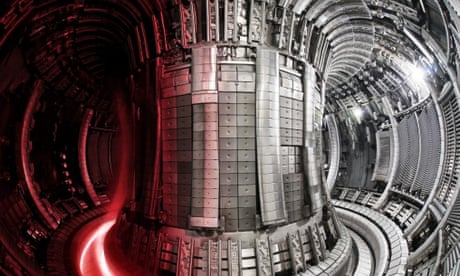- by foxnews
- 06 Jan 2025
Nuclear fusion heat record a ‘huge step’ in quest for new energy source
Nuclear fusion heat record a ‘huge step’ in quest for new energy source
- by theguardian
- 10 Feb 2022
- in news

The prospect of harnessing the power of the stars has moved a step closer to reality after scientists set a new record for the amount of energy released in a sustained fusion reaction.
Researchers at the Joint European Torus (JET), a fusion experiment in Oxfordshire, generated 59 megajoules of heat - equivalent to about 14kg of TNT - during a five-second burst of fusion, more than doubling the previous record of 21.7 megajoules set in 1997 by the same facility.
The feat announced on Wednesday follows more than two decades of tests and refinements at the Culham Centre for Fusion Energy and has been hailed as a "major milestone" on the road to fusion becoming a viable and sustainable low-carbon energy source.
"These landmark results have taken us a huge step closer to conquering one of the biggest scientific and engineering challenges of them all," said Prof Ian Chapman, the chief executive of the UK Atomic Energy Authority. "It's clear we must make significant changes to address the effects of climate change, and fusion offers so much potential."
The doughnut-shaped JET is built to contain plasmas, or highly ionised gases, which are heated to 150m degrees Celsius, 10 times hotter than the centre of the sun.
At such extreme temperatures, atomic nuclei can fuse together to form new elements and release vast amounts of energy. The same fusion reactions power the sun, but at considerably lower temperatures, because stars have gravity to lend a hand.
Experiments at JET have focused on whether fusion is feasible with a fuel based on two isotopes of hydrogen known as deuterium and tritium which combine to form helium gas. The latest results suggest that it is and provide crucial confirmation for Iter, a larger fusion project being built in the south of France. Iter is scheduled to start burning deuterium-tritium fuel in 2035 and ultimately generate more heat than is needed to keep its plasma at high temperature.
If all goes well with Iter, the next step is to build a European demonstration power plant that produces more electricity than it uses and is hooked up to the grid. The prospect of fusion energy is deeply attractive because it does not release greenhouse gases and 1kg of fusion fuel contains about 10m times as much energy as 1kg of coal, oil or gas.
While deuterium is abundantly available in sea water, tritium is extremely rare and produced in nuclear reactors. Future fusion plants - Iter included - are expected to make their own tritium fuel by using high-energy neutrons, released when deuterium and tritium fuse, to split the common metal lithium into tritium and helium.
Dr Mark Wenman, a reader in nuclear materials at Imperial College London, said that while the experiment released fusion energy for only five seconds, it proved that the fuel could be burned in a sustainable manner. "It's been a while since they have produced a record like this and it's a major milestone on the way to proving that fusion's a viable and sustainable energy source for the future.
"Five seconds doesn't sound like much, but if you can burn it for five seconds, presumably you could keep it stable and keep it burning for many minutes, hours, or days, which is what you are going to need for a proper fusion power plant. It's the proof of that concept that they have achieved," he said.
Prof Ian Fells, the emeritus professor of energy conversion at the University of Newcastle, said the record-breaking release of fusion energy was "a landmark" in fusion research. "Now it is up to the engineers to translate this into carbon-free electricity and mitigate the problem of climate change," he added.
- by foxnews
- descember 09, 2016
Truck driver intervenes in highway shootout, wins Goodyear Highway Hero Award
Two men have been awarded the Goodyear Highway Hero Award for their selfless acts in the commercial trucking industry. Here are their stories.
read more


